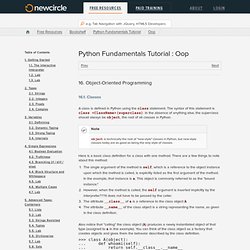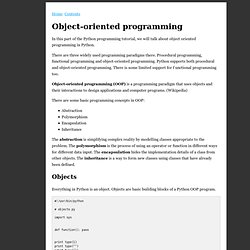PYTHON blog
> Sapamja
How to Think Like a Computer Scientist — How to Think Like a Computer Scientist: Learning with Python 2nd Edition documentation. Making a flat list out of list of lists in Python. Python Fundamentals Tutorial : Oop. A class is defined in Python using the class statement.

The syntax of this statement is class <ClassName>(superclass). In the absence of anything else, the superclass should always be object, the root of all classes in Python. Here is a basic class definition for a class with one method. There are a few things to note about this method: The single argument of the method is self, which is a reference to the object instance upon which the method is called, is explicitly listed as the first argument of the method.
Also notice that "calling" the class object (A) produces a newly instantiated object of that type (assigned to a in this example). >>> class A(object): ... def whoami(self): ... return self. The most commonly used special method of classes is the __init__() method, which is an initializer for the object. Notice also that the arguments are stored as object attributes, but those attributes are not defined anywhere before the initializer.
Peter's Website. Python Attributes and Methods. Chapter 1.

New Attribute Access What is an attribute? Quite simply, an attribute is a way to get from one object to another. Apply the power of the almighty dot - objectname.attributename - and voila! You now have the handle to another object. Which object does an attribute access return, though? Example 1.1. Ok, I admit 'user-provided attribute' is a term I made up, but I think it is useful to understand what is going on. We, however, are more interested in user-defined attributes. When accessed (for e.g. print objectname.attributename), the following objects are searched in sequence for the attribute: The object itself (objectname.
If all this hunting around fails to find a suitably named attribute, Python raises an AttributeError. The built-in dir() function returns a list of all attributes of an object. The above section explains the general mechanism for all objects. Some objects, such as built-in types and their instances (lists, tuples, etc.) do not have a __dict__.
Object oriented programming. HomeContents In this part of the Python programming tutorial, we will talk about object oriented programming in Python.

There are three widely used programming paradigms there. Procedural programming, functional programming and object-oriented programming. Python supports both procedural and object-oriented programming. There is some limited support for f unctional programming too. Object-oriented programming (OOP) is a programming paradigm that uses objects and their interactions to design applications and computer programs.
There are some basic programming concepts in OOP: AbstractionPolymorphismEncapsulationInheritance The abstraction is simplifying complex reality by modelling classes appropriate to the problem. Objects Everything in Python is an object. .
#! In this example we show, that all these entities are in fact objects.
Zone.effbot.org. Object oriented programming. Re: Python Interview Questions - Google Groupes. Code Like a Pythonista: Idiomatic Python. In this interactive tutorial, we'll cover many essential Python idioms and techniques in depth, adding immediately useful tools to your belt.

There are 3 versions of this presentation: ©2006-2008, licensed under a Creative Commons Attribution/Share-Alike (BY-SA) license. My credentials: I am a resident of Montreal,father of two great kids, husband of one special woman,a full-time Python programmer,author of the Docutils project and reStructuredText,an editor of the Python Enhancement Proposals (or PEPs),an organizer of PyCon 2007, and chair of PyCon 2008,a member of the Python Software Foundation,a Director of the Foundation for the past year, and its Secretary. In the tutorial I presented at PyCon 2006 (called Text & Data Processing), I was surprised at the reaction to some techniques I used that I had thought were common knowledge. Many of you will have seen some of these techniques and idioms before.
These are the guiding principles of Python, but are open to interpretation. Import this. The History of Python. Neopythonic.




